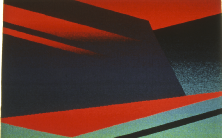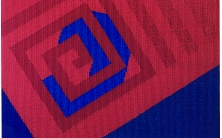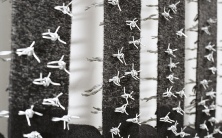





Tapestry Weaving -
“Having discovered tapestry weaving at college, I could not let it go.”
My (traditional) ideas about what an artist was -
Loom weaving was fascinating -
And so I persevered and, over what turned out to be a long period of time, came to
terms with the patience required to produce an even tension and a good selvedge.
Now it is not so much patience that is required as time. The time spent on weaving
is therapeutic, yogic -
Current Work
My current work in tapestry weaving has been gradually developing over the past ten years. Previous to this I worked my designs out in detail usually on paper. However, working with wire and barbed wire, I have found it more natural to develop my ideas in my mind first and then try them out directly in tapestry. Development of my work in this way tends to be slower which is not always convenient, but I find it suits me well and allows a more natural growth.
My ideas for tapestries come from a number of sources. The larger themes are conflict and regeneration but I am largely influenced by my background in Northern Ireland, the growth of my family and a special place in Scotland!
Weaving and Barbed Wire -
“Tenses” 1 – 4 (1998) are tapestries made initially in response to the “Peace Process” in Northern Ireland.
Having grown up in Belfast in the 1960’s and 1970’s, it has taken me nearly 30 years to find a way to express my feelings about the place and the way it has influenced both my work and my approach to life.
The tapestries are woven with a wool weft on a cotton warp. Barbed wire was inserted to the weave as it was being woven and this has been held rigid by securing it with aluminium wire to the wire mesh on which all four pieces are mounted.
The wire mesh is an important part of the finished works. It relates to the metal
in the weave, complements and extends the three-
In earlier years I often used the Irish landscape as the subject of my designs for tapestry. I feel now that a part of my reasons for using that subject matter was to deliberately ignore the troubles and pretend that life was normal. This is/was a common trait in Northern Ireland – is, perhaps, an essential human attribute. The length of time I have now been living away from Northern Ireland (18 years (1998)) has allowed me to take a more objective viewpoint of the situation and in doing so, I have been able to examine more closely the reasoning behind my feelings for the place.
The barbed wire in my tapestries acts, for me, as a symbol of many different aspects of the troubles in Northern Ireland as well as the difficulties and fighting in other parts of the world. It acts as a symbol for aspects of conflict on a more personal level as well and represents the contradictory nature of conflict in a physical way – the contrast of the materials used in the work is fascinating on its own. It can be difficult to work with which in turn can create conflict (along with cuts and bruises).
Although these and other pieces of my work are about conflict, this is not always recognised. People from a rural background often think more of the ways in which wire and barbed wire is used in farming than in more violent situations.
“Dialogue” and “Piece Process” (both 2001) are further developments of this theme and are a more direct response to what was happening with the peace process in Northern Ireland between 1998 and 2000.
The steel rods of “Dialogue” bend out from the wall as they rise and as such, wobble significantly if touched. The dialogue between all parties in any conflict is of a similar nature. “Piece Process” is named thus because so many of my ideas about the work have come from doing the work itself.
I have found that the materials I am using in this work dictate a different approach to developing my ideas. In my more traditionally woven tapestries I have always taken the design of the work to a relatively finished stage before weaving with only the final decisions about the piece being made during the weaving process. However, in using wires and steel mesh etc. I have found that I want and need to work through my ideas with the materials themselves.
“Untitled”
“Cycle II”
“Conflicting Arguments”